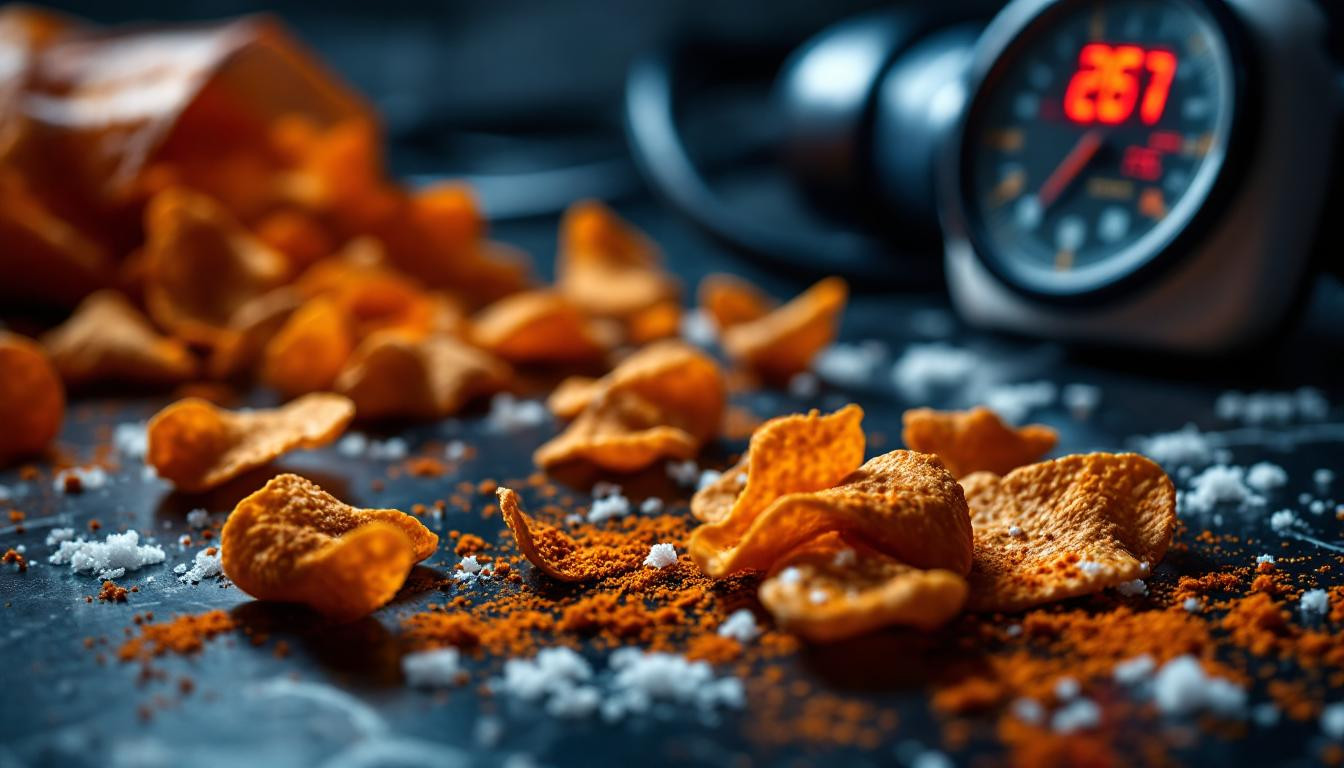Doritos Flamin’ Hot Cool Ranch combines two bold flavor profiles into one dangerously addictive snack that’s taking American pantries by storm. But behind the fiery heat and cool ranch tang lies a nutritional profile that deserves serious scrutiny. This seemingly innocent snack hides a surprising amount of health concerns that medical professionals are increasingly warning about.
The Salt Assault: A Sodium Nightmare in Disguise
A single serving (about 12 chips) of Doritos Flamin’ Hot Cool Ranch contains a staggering 190mg of sodium—8% of your daily recommended intake. But let’s be honest: who eats just 12 chips? A typical snacking session can easily reach half a bag, delivering up to 40% of your daily sodium limit in one sitting. This excessive sodium intake is directly linked to increased blood pressure and cardiovascular strain.
Dr. Melissa Hernandez, cardiologist at Southwestern Medical Center, explains: “The combination of high sodium and processed carbohydrates creates a perfect storm for cardiovascular health. I’ve seen patients reduce their blood pressure by 8-10 points simply by eliminating ultra-processed snacks like these from their diet.”
The Artificial Color Cocktail: More Than Just Eye Candy
The vibrant red-orange dust coating these chips comes from a concerning blend of artificial colors including Red 40 Lake, Yellow 6 Lake, Yellow 5, and Blue 1. These petroleum-derived dyes have been linked to behavioral issues in children and potential allergenicity in sensitive individuals.
Research published in the International Journal of Occupational and Environmental Health has found correlations between artificial food dyes and increased hyperactivity in children. These same dyes are actually banned or require warning labels in several European countries—yet remain unregulated in American snack foods.
The Flavor Enhancement Trap: MSG and Beyond
The ingredient list reveals multiple flavor enhancers designed to trigger your brain’s reward system:
- Monosodium glutamate (MSG)
- Disodium inosinate
- Disodium guanylate
- Maltodextrin
These compounds create what food scientists call “hyperpalatability”—a sensory experience specifically engineered to override your body’s natural satiety signals. This explains why the familiar “you can’t eat just one” sensation is a scientifically designed response, not just a lack of willpower.
The Oil Factor: Inflammatory Concerns
These chips are fried in a combination of corn, canola, and/or sunflower oils—highly refined vegetable oils that may contribute to inflammation when consumed regularly. The processing of these oils at high temperatures creates compounds that promote oxidative stress in the body, potentially contributing to chronic inflammatory conditions.
“The vegetable oils used in ultra-processed foods like flavored chips undergo extensive processing that alters their chemical structure. Regular consumption can increase inflammatory markers that we routinely test for in patients with chronic conditions,” notes Dr. James Wilson, nutritional biochemist at Central University.
The Empty Calorie Equation: Nutritional Void
At 150 calories per small serving, these chips provide virtually no beneficial nutrients—just 1g of fiber and negligible vitamins or minerals. Your body processes these as what nutritionists call “empty calories,” providing energy without nutritional benefit. This creates a metabolic debt that your body must pay by drawing on nutrient reserves.
Real-World Impact: The Snacking Cycle
Medical professionals report seeing patterns among regular consumers of highly processed snacks. Gastroenterologist Dr. Sarah Chen shares: “I had a patient who consumed flavored chips 4-5 times weekly who presented with persistent digestive discomfort and elevated inflammatory markers. After eliminating these ultra-processed snacks, both symptoms and blood markers improved within just three weeks.”
Healthier Alternatives Worth Trying
If you crave that satisfying crunch and bold flavor, consider these alternatives with dramatically better nutritional profiles:
- Air-popped popcorn with nutritional yeast and a pinch of cayenne
- Baked corn tortillas with fresh salsa and herbs
- Roasted chickpeas with ranch seasoning (made from dried herbs)
For the adventurous, try making your own chips: brush corn tortillas with olive oil, sprinkle with spices, and bake until crisp. You’ll cut sodium by 75% and eliminate artificial additives entirely while still enjoying that satisfying crunch.
Think of your body as a high-performance vehicle: filling it with premium fuel ensures optimal performance, while consistently choosing low-quality options eventually leads to system breakdowns. What you snack on today shapes your health tomorrow—choose wisely.
For better snacking alternatives that won’t compromise your health, check out these 6 foods that can actually improve heart health or discover how dark chocolate could help lower blood pressure for a treat that actually benefits your body.
